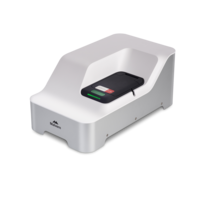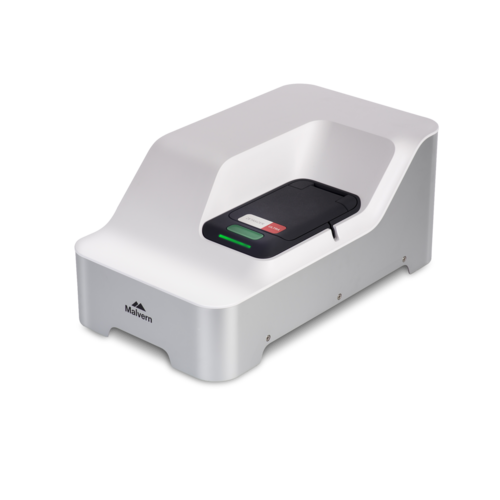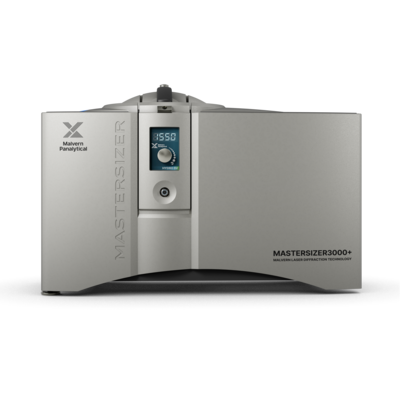Zetasizer Ultra
World’s most advanced light scattering system
- MADLS scheme for absolute confidence in particle and molecular size distribution analysis
- NIBS optics for versatile, high sensitivity, particle and molecular size measurements
- Simple, per-peak concentration / titer measurements (Red Label only)
- Disposable capillary sizing cell provides the ultimate in non-destructive, low volume (down to 3 µL) analysis, with an upper size range that extends to 10 μm
The Zetasizer Ultra is Malvern Panalytical’s most advanced system for the measurement of particle and molecular size, particle charge and particle concentration, and represents the most intelligent and flexible instrument in the Zetasizer Advance range.
This flagship model enjoys all the benefits afforded by ZS Xplorer software, in terms of ease of use, analysis speed and data confidence, and also offers two unique measurement capabilities: Multi-Angle Dynamic Light Scattering (MADLS) and particle concentration, to offer even greater insight into your samples.
The Zetasizer Ultra is the world’s most capable combined DLS and ELS system, incorporating Non-Invasive Back Scatter (NIBS) and, uniquely, MADLS technology for the measurement of particle and molecular size. NIBS provides the versatility and sensitivity to measure over a wide concentration range, while MADLS permits a higher resolution view into your sample’s size distribution for those critical measurements.
An extension to MADLS on the Zetasizer Ultra Red Label affords the ability to directly analyze particle concentration. The measurement of particle concentration is suitable for a wide range of materials, requires no or little dilution, and is quick to use – all of which make it ideal as a screening technique. This is a unique capability of the Zetasizer Ultra which can even be applied to samples such as viruses and virus-like particles (VLPs), which were previously very challenging to measure.
The Zetasizer Ultra is used in many applications, including:
Academia
The Zetasizer Ultra is an essential analytical tool for many academic laboratories worldwide, finding use in all applications where particle or molecular size and zeta potential analysis is required. The breadth of applications covered by Zetasizer systems, coupled with tens of thousands of scientific citations, have earned these instruments a central space in many scientific faculties.
Bioscience
Variations in molecule concentration, external temperature, level of agitation and time all impact the stability of biological molecules. Instabilities mainly result in denaturation and aggregation of the molecule through which they can lose their biological function , elicit an immune response and consequently limit its therapeutic viability. Factors affecting therapeutic efficacy and immunogenicity therefore need to be monitored throughout the development pipeline especially at early stages to de-risk the biological drug molecule and limit late-stage failures. The Zetasizer range provides high quality, stability indicating data for biological drug molecules in a short time frame, enabling this measurement to be implemented throughout the development pipeline.
Food and drink
Zetasizer systems are used to analyze particle size and zeta potential to improve the appearance and taste of foods, drinks and flavorings, and optimize dispersion and emulsion stability to extend product shelf life and improve product performance.
Nanomaterials
Zetasizer measurements of nanoparticle size distribution, dispersion properties, stability and propensity to aggregate are crucial to the design of new nanomaterials. The very large surface area of such materials may result in novel physical and chemical properties, such as increased catalytic activity, improved solubility or unexpected optical or toxicological behaviour.
Paints, inks and coatings
Paint, ink and coating formulations must be stable to keep them in an optimum state over time without change or aggregation. Particle size and zeta potential, measured by the Zetasizer instruments, play important roles in determining a product’s properties, such as dispersibility, color, strength, finish, durability and shelf life.
Pharmaceuticals
The correct particle size and zeta potential can help ensure the production of effective therapeutics, delivered safely. Zetasizer systems are used to characterize the stability and quality of dispersions, emulsions and creams, reducing formulation time and speeding new products to market.
Particle size and molecular size
| Measurement principle | Non-Invasive Back Scatter (NIBS) Dynamic Light Scattering Dynamic Light Scattering (90° and 13°) Multi-Angle Dynamic Light Scattering (MADLS) |
| Measurement angle | 173°, 13°, 90° |
| Measurement range | Diameter: 0.3 nm - 15 μm (2) (9) |
| Minimum sample volume | 3 μL |
| Concentration range | Minimum sample concentration: Blue Label: 0.2 mg/mL 15 kDa Protein Red Label: 0.1 mg/mL 15 kDa Protein MADLS: 0.1 mg/ml 15 kDa Protein MADLS Particle Concentration Enabled? Blue Label: No Red Label: Yes Maximum sample concentration(3): 40% w/v |
Zeta potential
| Measurement principle | Mixed-Mode Measurement phase analysis light scattering (M3-PALS) |
| Size range | 3.8 nm – 100 μm |
| Minimum sample volume | 20 μL (4) |
| Concentration range | Red Label: 1 mg/mL (5) to 40% w/v (6) Blue Label: 10 mg/mL (5) to 40% w/v (6) |
| Sample conductivity range | Maximum: 260 mS/cm |
Static Light Scattering (molecular weight)
| Molecular weight range | 980 Da – 20 MDa |
| Measurement principle | Static Light Scattering with Debye Plot (10) |
| Accuracy | +/- 10% typical |
Particle concentration
| Measurement principle | Blue Label: N/A Red Label: MADLS - Particle Concentration (Mie) |
| Concentration range | Blue Label: N/A Red Label: 1x108 to 1x1012 particles/mL |
| Calibration type | Blue Label: N/A Red Label: Single point system calibration only |
System
| Detector | Avalanche Photodiode |
| Laser safety | He-Ne (633 nm) Blue label: 4 mW Max Red label: 10 mW Max |
| Temperature control range | 0°C to 120°C (7) |
| Dimensions (W, D, H) | 322 mm x 565 mm x 245 mm |
| Weight | 19 kg |
| Power | AC 100-240 V, 50-60 Hz, 4.0 A |
| Power consumption | Max 100 W, Typical 45 W |
| Ambient conditions | +10°C to +35°C, 35 - 80% RH (non-condensing) |
| Interface | USB 2.0 or higher |
Footnotes
1 - Water as dispersant
2 - Indicative data available for particle sizes greater than 10 μm when using Extended Size Range analysis and low volume disposable sizing cell accessory.
3 - Sample dependent
4 - Using patented diffusion barrier technique
5 - Measured using 15 kDa protein
6 - Measured using bile acid
7 - Dry nitrogen cell purge required for temperatures below dewpoint
8 - Accuracy 0.1°C at 25°C, 0.2°C at 0°C, 0.5°C at 90°C
9 - Recommended upper size range for MADLS is 500nm diameter.
10 - Software features to be introduced soon
Sysmex Nederland B.V.
Ecustraat 11
4879 NP Etten-Leur
The Netherlands
+31 (0)76 508 6000
+31 (0)76 508 6086
Sysmex Belgium N.V.
Chaussée de Bruxelles 135A
1310 La Hulpe
Belgium
+32 (0)2 769 7474
+32 (0)2 7697499
Zetasizer Advance DLS sizing, Advanced Training
The usage and data interpretation dynamic light scatter course provides knowledge, inspiration and tools for the use of the Malvern Panalytical Zetasizer Lab, Pro or Ultra for DLS analysis.
https://nl-be.sysmex-academy.com/learn/zetasizer-advance-dls-sizing-advanced-training-malvern
Zetasizer Advance Zeta Potential, Advanced Training
The usage and data interpretation zeta potential course provides knowledge, inspiration and tools for the use of the Malvern Panalytical Zetasizer Lab, Pro or Ultra for zeta potential analysis.
https://nl-be.sysmex-academy.com/learn/zetasizer-advance-zeta-potential-advanced-training-malvern


